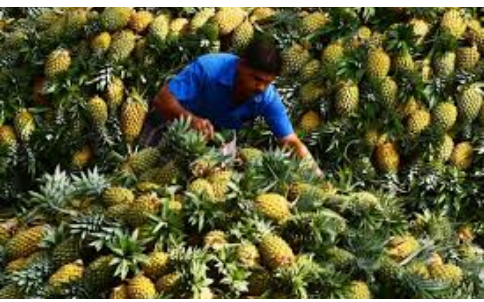India is well placed because of its agro-climate conditions and the abundant natural resource base for achieving agricultural production of a variety of commodities. The contributions of agricultural exports generally have forward and backward linkages. The agricultural trade balance between exports and imports during the past decade up to 2018 has been steady, however, the percentage share of total export was fluctuating in the previous decades. The agricultural growth rate in exports is 10.53% in 2017-18 and for the corresponding year the import growth rate is – 36.13%.
Also read: Agriculture subsidies in Inida
No doubt, the government has taken several measures for promoting exports. New Foreign Trade Policy was announced in April 2015 and it rationalised earlier export promotion schemes and initiated two more schemes and namely, Merchandise Exports from India Schemes (MEIS) for furthering exports of goods and Services Exports from India Schemes (SEIS) for increasing services. In these services duty credit scrips are made finally transferable. Labour intensive/ MSME sectors were given 2 % increased rate incentives with a financial implication of Rs. 8,450 cores per year.
Also read: The Lost Horizons
Private sector investment in research
Also interest equalization scheme came into effect from 2015 producing an incentive of 3% interest equalisation to MSME sectors. Further the rate was enlarged to 5% in 2018 and also the merchant exports were covered with effect from 2019. In order to meet exports, infrastructure gaps a new scheme titled “Trade Infrastructure for Export Scheme (TIES) was started in 2017. With an objective doubling the farmers’ income by 2022 a comprehensive Agriculture export policy” was announced towards the end of 2018. This was expected to provide the necessary push to agricultural exports.
Also read: Growth, Poverty reduction and inequality
The domestic agricultural sector also witnessed a vast change in the past few decades. This includes composition of private and public sector investments in agricultural research with greater involvement and participation of private sector. There has been the emergence of new institutional innovations like contract farming and farmer producer companies. There has been change in the mix of demand for agricultural commodities in the domestic market and international trade. This propelled diversification towards high value crops which led to differencial growth experience for different commodities. According to the scientists a paradigm shift is taking place in the focus of agricultural output.
Also read: Neglect of agricultural labourers
Collective bargaining power
It is interesting to note that though the quantum of agricultural exports showa steady trend, there is a consistent decline in the total exports from 20.05% to 10.53% during the decade under discussion. The LPG process (Liberalisation Privatisation and Globalisation) which started in 1990 was viewed by some as the main reason for the stunted agricultural crisis. Well thought of imports duty and quantitative restrictions on imported goods to protect farmers is vital. By 2001, India completely removed restrictions on imports of almost 1500 items including food. Liberalisation policies reduced pesticide and fertiliser subsidy which is an explicit condition of the IMF agreement. In the last, the developing countries have no other option than to comply with the WTO agreement for exports. The exports of India can brighten from the use of the collective bargaining power exerted by the developing countries which alone can help all developing countries in turn.
Also read: Backdrop of Indian Agriculture
Different set of other problems exist. Faster transmission of international price volatility to domestic markets and higher rates of rejection due to sanitary and phyto sanitary (SPS) measure are such conspicuous issues.
Also read: Ageing India looks for a decent living
The Indian government and also the state governments need to take effective steps to expand the agricultural exports along with measures for helping and motivating the exporters. Further innovations are called for in pre-harvest and post-harvest activities in crop production and marketing.
Also read: Musings on pandemic impacts




